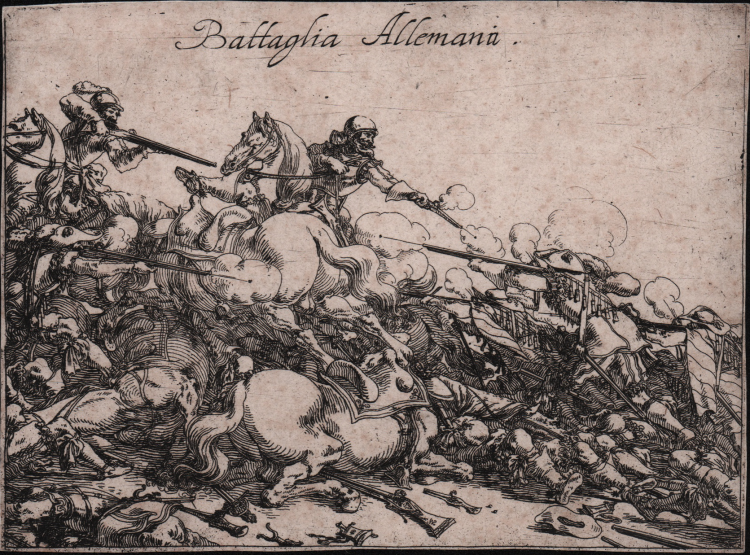



| Reference: | S45477 |
| Author | Johann Wilhelm BAUR |
| Year: | 1633 |
| Measures: | 140 x 104 mm |


| Reference: | S45477 |
| Author | Johann Wilhelm BAUR |
| Year: | 1633 |
| Measures: | 140 x 104 mm |
Battle scene with a soldier on horseback.
Etching, circa 1633, lettered at upper centre: 'Battaglia Allemanii'.
The German battle scene with soldiers on on horseback. From a series of thirteen etchings of battle scenes of different nations. 1633. This from a rare set, both the British Museum and the Rijksmuseum hold only an incomplete set
A good impression, printed on contemporary laid paper, trimmed to the borderline, light foxing, otherwise very good.
Johann Wilhelm Baur, Joan Guiliam Bouwer or Bauer (Strasbourg, May 31, 1607 - Vienna, January 1, 1640) was a German engraver, etcher and miniature painter. Baur, born in Strasbourg and trained here under the miniaturist Friedrich Brentel, arrived in Italy in the early 1630s and stayed mainly between Rome and Naples. Various testimonies of these years remain, for example the album of drawings preserved in Strasbourg (Musée des Beaux Arts), some sheets of which bear the annotation "Rome 1633" and "Rome 1637," and two other miniatures in a circular format but larger in size, representing Piazza San Pietro and Piazza di Santa Maria Maggiore, linked to the Borghese collection; Prince Marcantonio was not the only one among the members of the major noble families to have close relations with Baur, who enjoyed the protection of the Duke of Bracciano, Marquis Giustiniani, the Colonna and the Orsini. Around 1637, Baur left Rome and moved to Vienna, where he remained until his death, working at the court of Emperor Ferdinand III of Habsburg.
Bibliografia
Hollstein, German engravings, etchings and woodcuts c.1400-1700 (25); Bonnefoit 1997, Johann Wilhelm Baur (1607-1642). Ein Wegbereiter der barocken Kunst in Deutschland (R 31-44).
Johann Wilhelm BAUR (1607, Strasburgo - 1640, Vienna)
|
Johann Wilhelm Baur, Joan Guiliam Bouwer, or Bauer (Strasbourg, 31 May 1607 - Vienna, 1 January 1640) was a German engraver, etcher and miniature painter. He is famous for a series of illustrations of Ovid's Metamorphoses.
According to Houbraken, he learned to draw and paint from the miniaturist Friedrich Brentel in Strasbourg, before embarking on a Grand Tour to Rome, where he painted for Brassiano, a known patron of the arts. He specialized in watercolors of architectural follies in perspective, and for this reason was often employed to make pictures of gardens. He had the habit of talking when he was concentrating and was known to have conversations with inanimate objects. In 1634 he broke off a trip to Naples to return to a woman in Rome. According to Cornelis de Bie, Baur lived with Karel Škréta (Carolus Creten) while he was in Rome. Creten was a member of the Bentvueghels with the nickname Slach-sweerd. The RKD has assigned this nickname Slagzwaard (longsword) to Baur himself, who was probably also a member of the Bentvueghels, but whose nickname was not recorded by De Bie.
Many of his drawings of Ovid's stories, the passion of Christ in 24 plates, and scenes of daily life in Rome (with costumes of various nationalities) were engraved by Melchior Küsel of Augsburg. He died in Vienna of a sudden illness while on a commission by Ferdinand III, Holy Roman Emperor.
|
Johann Wilhelm BAUR (1607, Strasburgo - 1640, Vienna)
|
Johann Wilhelm Baur, Joan Guiliam Bouwer, or Bauer (Strasbourg, 31 May 1607 - Vienna, 1 January 1640) was a German engraver, etcher and miniature painter. He is famous for a series of illustrations of Ovid's Metamorphoses.
According to Houbraken, he learned to draw and paint from the miniaturist Friedrich Brentel in Strasbourg, before embarking on a Grand Tour to Rome, where he painted for Brassiano, a known patron of the arts. He specialized in watercolors of architectural follies in perspective, and for this reason was often employed to make pictures of gardens. He had the habit of talking when he was concentrating and was known to have conversations with inanimate objects. In 1634 he broke off a trip to Naples to return to a woman in Rome. According to Cornelis de Bie, Baur lived with Karel Škréta (Carolus Creten) while he was in Rome. Creten was a member of the Bentvueghels with the nickname Slach-sweerd. The RKD has assigned this nickname Slagzwaard (longsword) to Baur himself, who was probably also a member of the Bentvueghels, but whose nickname was not recorded by De Bie.
Many of his drawings of Ovid's stories, the passion of Christ in 24 plates, and scenes of daily life in Rome (with costumes of various nationalities) were engraved by Melchior Küsel of Augsburg. He died in Vienna of a sudden illness while on a commission by Ferdinand III, Holy Roman Emperor.
|